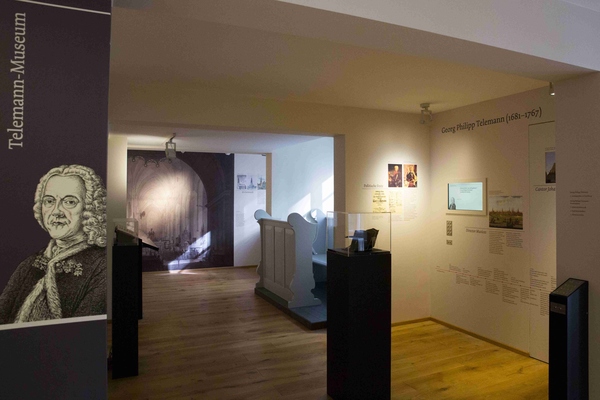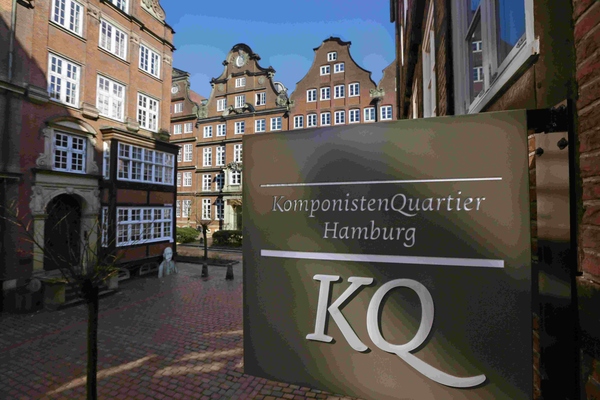



im KomponistenQuartier Hamburg
Peterstraße 28
20355 Hamburg
Telefon: +49. 40. 87604 022
Web: www.telemann-hamburg.de
E-Mail: info@komponistenquartier.de
Dienstag - Sonntag und an Feiertagen:
10 bis 17 Uhr
1.1., 24.12, 25.12., 31.12.:
geschlossen
Das Telemann-Museum Hamburg, das erste weltweit, wurde aufgrund privater Initiative und mit teilweiser öffentlicher Förderung 2011 im historischen Beylingstift von 1751 in der Anlage der Carl-Toepfer-Stiftung eröffnet. In jetzt größerenund neu gestalteten Räumen befindet es sich seit März 2015 im Haus Peterstarße 31 – vereint mit Museen für die Komponisten Carl Philipp Emanuel Bach und Johann Adolf Hasse. Besucher können sich somit über drei bedeutende Komponisten des 18. Jahrhunderts informieren.
Im Telemann-Museum stehen seine Hamburger Lebens- und Wirkungsjahre im Vordergrund. Ausführlich behandelt werden die Schaffensgebiete Kirchenmusik, öffentliche/bürgerliche Musik, Telemanns Bedeutung für die Hamburger Gänsemarktoper und seine Betätigung als Publizist und Verleger. Im Besitz des Museums befindliche originale Archivalien des 18. Jahrhunderts werden in Kopien ebenso präsentiert wie Erstdrucke von Texten der Werke Telemanns mit Hamburg-Bezug. Mittelpunkt eines Ausstellungsraumes ist ein originales Spinett von Thomas Hitchcock aus dem Jahre 1730, das zu den kleinen Konzerten im Museum erklingt. Überdies verfügt das Telemann-Museum über eine stattliche Bibliothek mit Schwerpunkten auf Kultur- und Musikgeschichte Hamburgs im 18. Jahrhundert
Der Lichtwark-Saal der Carl-Toepfer-Stiftung ist Heimstatt des musikalischen Angebots der Gesellschaft für Mitglieder und Gäste.
Deutschland verfügt über musikalische Traditionen und Nachlässe von außerordentlichem Wert: Händel, Schütz und Bach, Beethoven, Mendelssohn, Schumann, Brahms und Wagner sind - um nur einige Namen zu nennen - weltweit bekannte und geschätzte Komponisten. Ihr Wirken hat eine einzigartige Musiklandschaft wesentlich mitgeformt.
Zahlreiche Orchester, Chöre und Ensembles, renommierte Musikfestivals und -reihen, Musikerhäuser mit Museen, öffentliche Archive und Bibliotheken, aber auch private Sammlungen bewahren ihr musikalisches Erbe.
Diesen unschätzbaren Fundus gilt es immer wieder neu zu beleben und für die Gegenwart zu erschließen. Den in der Arbeitsgemeinschaft Musikermuseen Deutschlands zuusammengeschlossenen Häusern kommt dabei eine wichtige Rolle zu. In ihnen begegnen wir dem Werk von Musikern und Komponisten, die die Kulturnation Deutschland außerordentlich bereichert haben. Über das individuelle Portrait, über die Vermittlung des einzelnen Œuvres hinaus tragen die Musikermuseen aber auch zur Pflege musikalischer Tradition insgesamt bei. Die vorliegende Broschüre unterstreicht diesen Aspekt der Zusammenschau, und sie lädt zu einer Reise in die Musikgeschichte Deutschlands ein. Ich wünsche diesem Reiseführer regen Gebrauch und eine große Resonanz.
Bernd Neumann, MdB
Staatsminister bei der Bundeskanzlerin
Der Beauftragte der Bundesregierung für Kultur und Medien
Zitat: Vorwort zur Broschüre der Arbeitsgemeinschaft "Musikermuseen in Deutschland", 2007.